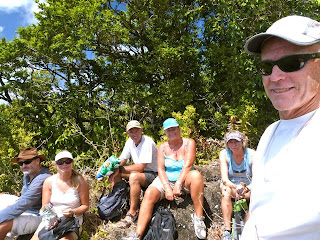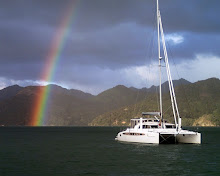From The Samoan Island of Savai’i, we pointed “Blue Rodeo”
south, for the first time in many months, and sailed to the tiny island of
Niuatoputapu in the northern portion of the Kingdom of Tonga. Our landfall, shortly after sunrise, treated
us to an impressive view of a cone-shaped, volcanic island just northwest of
Niuatoputapu itself. It clearly served
as a reminder of what geological processes created these tropical islands. In fact, volcanic activity continues to this
day and our charts indicate the presence of undersea mountains that rise from
the depths to just hundreds of feet below the surface and occasionally spew
steam, ash and even pumice into the atmosphere.
We imagined how frightening it might be to be sailing peacefully along
and suddenly be at “ground zero’ during one of the eruptions.
Like many of the Pacific islands, Niuatoputapu (known by
cruisers who have trouble with the pronunciation as “New Potatoes”) is
surrounded by coral reefs and requires careful navigation to safely approach
the harbor off the main village. We
found the entrance easy enough and were soon anchored off the village’s town
wharf with our yellow “Q” (quarantine flag) hoisted to our mast’s starboard
spreader. While we waited for the
arrival of the immigration, customs and health and agriculture officials we were
joined in the anchorage by our friends on the yachts “Malarkey” and “Awaroa”
who had also sailed from Samoa. We also
received a radio call from a friendly local woman named Sia who welcomed us to
the island and offered to help with any services we might need and suggested
that we join her and her family ashore the next evening for a pot luck dinner.
After a short while, three officials arrived at the wharf in
a rather rusty and worn-looking pickup truck.
Mark ferried them to “Blue Rodeo” with our dinghy and we completed the
clearing-in process. Despite the
condition of their vehicle, the officials were nicely dressed in traditional
Tongan business attire with long skirts for the women and similar, ankle length
skirts for the men. Around their waists
were woven wrappings made from strips of palm leaves. Having completed the paperwork aboard our
boats, we all went ashore with the officials where we were given a ride in the
bed of their truck to their offices where we could change US dollars for their
currency and pay our check-in fees. The
ride proved interesting as we were afforded the first opportunity to see how
the island’s residents lived and what efforts were being made to rebuild the
villages after a deadly tsunami destroyed most of the near-shore structures in
2009.
During the next few
days we would learn in detail how a nearby earthquake produced a 30’ high wall
of water that swept ashore killing 9 people and creating widespread
destruction. Even though it had been
several years since the tsunami, many were still living in shacks made from
salvaged materials while, with the help of foreign aid, new villages were being
built on higher ground. Even though the
modest new homes were being offered as free replacements to families that had
lost everything, some were unwilling to leave their original land, choosing
instead to live in whatever they could scrape together.
Our pot luck dinner, where we cruisers provided most of the
food, with Sia, her husband Nico and their 4 children proved interesting as we
learned more about the way they lived, the tsunami and the island culture. It was made clear how needy many of the
island’s 870 residents were and, before sailing on, we all brought ashore gifts
of food items and anything else we could spare.
Our days on Niuatoputapu passed quickly and were filled with
socializing, touring the island on rental bicycles guided by one of Sia’s sons,
hiking to the top of the island’s central, jungle-covered mountain and
snorkeling its surrounding reefs. Sadly,
the near-shore reefs were still showing the impact of the tsunami damage with
most of the coral in rather bad shape.
We can only image that it will take many years for them to recover from
the natural disaster.
Prior to leaving the island we joined most of its residents
for their Sunday church service where we were truly impressed by the beautiful
hymns sung by the choir in their native Tongan language. Even though we could not understand the words
in the songs or sermon, we couldn’t help but be moved by what we observed. We were especially moved by the smiles,
friendly faces and welcoming attitude by all of the people we encountered.


















So glad you are having such incredible experiences. Sounds wonderful, and your blog is fascinating. Miss you guys but so pleased for you!
ReplyDeleteEnjoyed reading your blog entry on Niua and Tafahi - my husband is from Tafahi and lives in US now and is quite homesick. Any chance you could possibly download your photos of the island - the close-up where you can see the village and also the one from Niua looking across the ocean to the island.If so, that would be wonderful as they would make him happy. I can be reached at tafahijoe@gmail. Hope to hear from you soon - fair winds and following seas! P.S. How's the beachcombing?
ReplyDelete